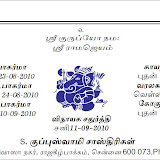
VEDAS
The word 'Veda' is evolved from the root 'Vid' which means 'to know'. The term 'Veda' means knowledge.
Vedas are also known as 'Shruti' the word 'Shruti'is evolved from the root 'Shru' which means 'to hear'. It is said that the Gods dictated the Vedas and the Sages first 'heard them' and memorised them. It was passed on to successive generations verbally for thousands of years.There are Four Vedas - Rigveda, Yajurveda, Samveda and Atharvaveda. From the endless Vedas, how much ever is required to be learnt by jeevan for its samskara and to intermingle with paramporual, such knowledge is called veda saaka a part of veda.
In Rigveda – 21 saakas
In Yajurveda – 109 saakas
( In sukla yajur – 15 saakas, In krishna yajur – 94 saakas)
In sama veda -1000 saakas
In adharva veda – 50 saakas,thus 1180 saakas are there according to Vishnu Purana.
METHODS OF LEARNING VEDAS:
1. Learning mantras as it is known as Samhitha paatam / vaakya paatam.
2. Learning by splitting each word in the vedic sentences is known as Padha paatam.
3. Learning by combining first word of mantra with the second, second word with third,third word with fourth is known as Karma paatam.Those who mastered Vedas in this manner is called karma viththars.
4. Learning by combination of two words together is known as Jataa paatam.Those who are experienced in this method are called jataa valabhaas.
5. Learning by combination of three words to the front and back is known as Sika paatam.
6. Another different method is Mala paatam.
7. Furthur telling the words to the front and back in several ways is known as Gana paatam.
8. Thando ganam.
9. Ratho ganam.
10. Thvajo ganam.









